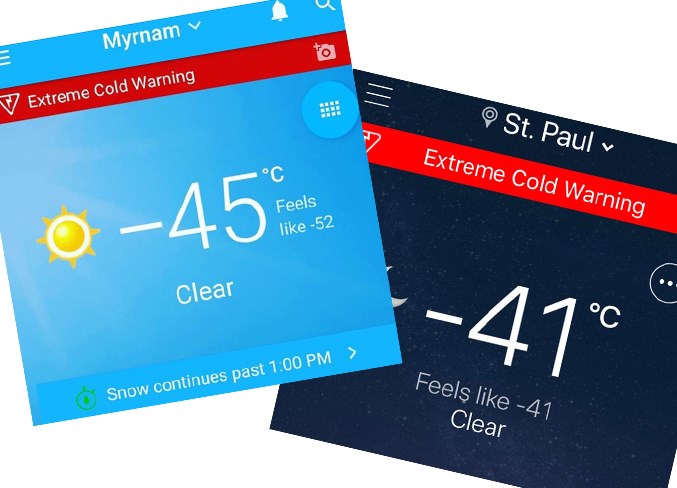With a low of -45 degrees Celsius before the wind chill, the Village of Myrnam had the distinct honour of being the coldest place in Alberta for several hours on Feb. 5. That’s according to data from the Environment Canada website, which collects hourly data from weather stations all across the province.
Dan Kulak, a meteorologist with Environment Canada says the cold temperatures are part of the “polar vortex” making headlines across North America.
“It’s part of the polar vortex phenomenon, but basically it’s winter,” said Kulak.
“The polar vortex has been around longer than Canada has been a country, it’s just part of the atmosphere that forms in the wintertime and is responsible for a lot of cold air, and sometimes that cold air really moves southwards in to the prairies like we’re getting right now.”
Kulak said while the temperatures are particularly low for the foreseeable future, it’s not unusual to have a cold snap.
“You don’t always get -40s, but it’s certainly not an unheard of thing for the province here and we don’t get them as often as we used to,” said Kulak.
Buses
Locally, the extreme weather was cited as the reason for rural bus cancellations by St. Paul Education throughout the week, and the disruption of snow removal services by the Town of St. Paul, specifically on Feb. 5.
“Our threshold is -40 or colder, including wind chill. So that is our threshold that if it is that temperature, a decision will be made that we will cancel busing,” said Glen Brodziak, the superintendent for SPERD, on Feb. 5.
Although buses for students living in the County of St. Paul were cancelled for several days, buses continued to run within the Town of St. Paul and schools remained open throughout the week.
“We are cognizant that if you know the bus isn’t running then there’s a lot of behind the scenes work with needing to get a babysitter and do this. So we try, even though it might be some work, we try to keep buses running in St. Paul,” said Brodziak.
According to Brodziak, the division’s transportation department starts checking the road and weather conditions as early as 5 a.m. every day and the decision to cancel buses or not also includes data from The Weather Network and contacts in each individual school.
“This week we’ve been making the decision the night before,” said Brodziak, citing the predictability of the extreme cold. On Wednesday, rural buses were cancelled again, making it the third day in a row.
“Schools remain open, education will still go on, but any kid who rides the bus and doesn’t make it to school, they will be caught up,” said Brodziak, who noted the method of catching students up would be left to the individual teacher's discretion.
“Is half the class there? Are there two students there? Are 90 per cent there? It’s easier to catch up a couple than to teach the entire lesson again,” said Brodziak.
Snow removal
In the Town of St. Paul, snow removal services were cancelled part way through the day on Feb. 5. Steven Jeffery, the director of public works, said the decision was made partly because of the extreme cold, but also because of the staffing levels the town had available to work.
“We ran our night-shift last night, and there was some work left over the crew wasn’t able to finish because of the heavy snowfall. So rather than putting out more work, we had enough to finish from last night. And then we’ll be starting back again tomorrow (Feb. 6) morning,” said Jeffery, who noted that whenever the town has staff on a night-shift for snow removal it results in limited resources the following day.
“It is a bit of an undertaking for the staff because on short notice they have to go home, get some rest, come back overnight and then resume day shift,” said Jeffery.
He said he didn’t expect the extreme cold to continue to be an issue for town staff, as they had completed snow removal from the priority one areas and would be able to do the rest of the work during the daytime hours when it is slightly less cold.
“We have quite a few areas listed as priority one on our snow removal policy, but the main ones are Main Street, so 50th Ave, the hospital route, so the streets and avenues around the hospital, the courthouse and provincial building, and schools. Among others, but that’s the main focus,” said Jeffery.
“Town staff are working hard to make sure those priority one areas are open and passable," he added.
He said once the priority one areas are cleared, they resume snow removal for the rest of town in the usual manner. Jeffery did note that the increased snowfall means it will take a bit more time to get everything cleared, as compared to after a lighter snowfall.



